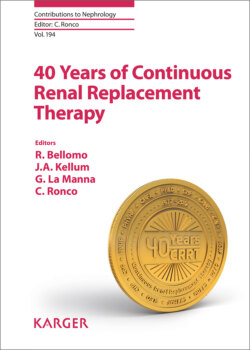Читать книгу 40 Years of Continuous Renal Replacement Therapy - Группа авторов - Страница 35
На сайте Литреса книга снята с продажи.
Side Effects and Complications of RCA
ОглавлениеPlasma citrate concentration depends on the balance between citrate input (infusion rate) and loss (filtration, metabolic degradation, additional loss through dialysis in continuous veno-venous hemodiafiltration). Plasma citrate is mainly bound to calcium and, to a lesser extent, to other cations such as magnesium. Dependent on metabolism and infusion rate, the accumulation of citrate may be associated with metabolic acidosis or metabolic alkalosis. Citrate may accumulate when liver and muscle fail to metabolize citric acid, as seen in decompensated liver cirrhosis, severe shock, or following a prolonged cardiac arrest. According to the Stewart acid-base approach, strong anions increase and metabolic acidosis develops. In a majority of cases, an increase in citrate is also reflected by a rising anion gap. Simultaneous increase of lactate is often observed. When citrate binds to calcium, systemic ionized calcium concentrations fall and the bound fraction of calcium rises. Total calcium concentration remains constant but mostly increases in the function of the amount of calcium infused. If calcium infusion is increased to correct low ionized calcium levels, most of the calcium is captured by citrate. Consequently, a disproportional rise in total calcium concentration occurs, while ionized calcium remains low. Thus, the calcium gap (total calcium minus ionized calcium) or the calcium ratio (total calcium/ionized calcium) will increase. A calcium gap >2.5 in the absence of any obvious cause of metabolic acidosis, is a valuable indicator of citrate accumulation. Using a lower (e.g., 0.5%) concentration of citrate should minimalize metabolic alterations [18–20]. Therapy includes tapering or discontinuation of citrate infusion and replacement with normal sodium and/or bicarbonate-buffered substitution fluids. In liver failure, continuous veno-venous hemofiltration (CVVH) can generally be continued without or at a 50% reduced anticoagulation dose because of pathology-bound coexisting coagulation disorders.
A gradually declining UF flow due to increased filter clogging [9] at constant blood flow and citrate infusion rate will result in less citrate and bicarbonate loss and more citrate entering the systemic circulation. A normally functioning liver will metabolize the excess citrate and metabolic alkalosis ensues. Ionized calcium concentration subsequently falls and, as a result of alkalosis, calcium ratio may rise proportionally. Metabolic alkalosis at reduced UF flow can be controlled by changing the filter and not by reducing citrate dose since this may precipitate filter clotting. A lower limit of UF flow has to be determined in function of blood and citrate flow. For instance, at a blood and citrate flow of respectively 200 mL/min and 35 mmol/h, a filter change is envisaged when the UF flow remains lower than 2,000 mL/h or when the trans-membrane pressure (TMP) exceeds 250 mm Hg [15, 21]. This threshold TMP better reflects a decline in filter porosity than monitoring UF flow. Since a higher renal replacement dose may improve mortality in patients with acute kidney injury, continuing CVVH at lower UF flows is not advised. Importantly, the need for filter change is not determined by a solitary TMP value but by the evolution of the slope of the TMP curve over time. Timely filter change also is the best way to prevent metabolic alkalosis. Citrate accumulation accompanied by metabolic alkalosis and hypocalcemia may also occur if too much citrate is accidentally infused in an occasional patient who received a high transfusion load at low UF flow. More calcium is lost in the ultrafiltrate during CVVH under RCA than under heparin. In this case, hypocalcemia is not accompanied by an increase in anion gap and adjustment necessitates calcium infusion via a separate line. The required amount depends on both UF flow and calcium content of the replacement fluid. At a sufficiently high UF flow (2,000 mL/h), additional calcium infusion is not needed if the replacement fluid contains calcium [22]. However, this scenario rarely occurs and calcium infusion through a dedicated central venous line must always be provided.
